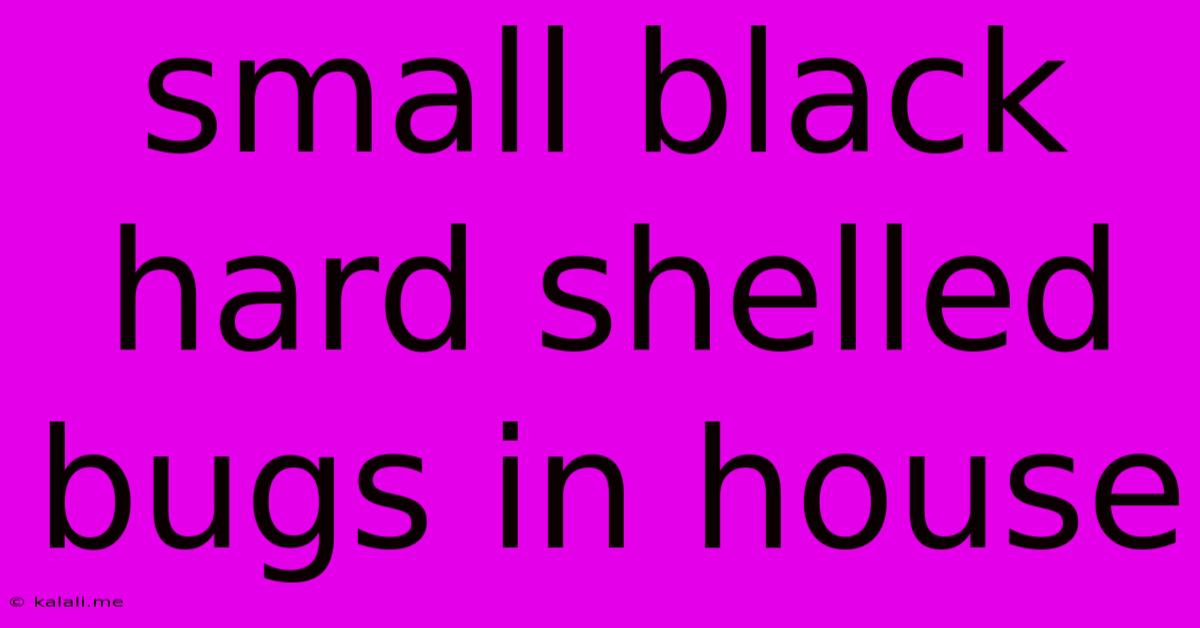Small Black Hard Shelled Bugs In House
Kalali
May 22, 2025 · 3 min read

Table of Contents
Small Black Hard-Shelled Bugs in Your House: Identification and Control
Are you dealing with an infestation of tiny, black, hard-shelled bugs in your house? This is a common problem, but identifying the specific culprit is crucial for effective treatment. This article will help you pinpoint the likely intruders and offer solutions for eliminating them. Knowing what you're up against is the first step to regaining control of your home.
These small, black, hard-shelled bugs could be several different insects. Proper identification is vital because different pests require different control methods. Let's explore some of the most common possibilities.
Common Culprits: Identifying Your Tiny Black Invaders
Several small, black, hard-shelled insects might be invading your home. Here are some of the most likely candidates:
-
Carpet Beetles: These are small, oval-shaped beetles with a hard shell. Their larvae are often the more noticeable problem, as they are fuzzy and move quite slowly. They feed on natural fibers like wool, silk, and cotton, often found in carpets, upholstery, and stored fabrics.
-
Drugstore Beetles: These beetles are known for infesting stored food products, particularly spices, dried herbs, and grains. They're small, oval, and shiny black.
-
Flour Beetles: Similar in size and shape to drugstore beetles, flour beetles are also common pantry pests. They infest flour, cereals, and other dry goods. They're attracted to moisture and warmth.
-
Black Carpet Beetles: These beetles are a specific type of carpet beetle, often larger and more easily identified due to their distinctive markings. Similar to other carpet beetles, their larvae cause significant damage to fabrics.
Locating the Source of the Infestation
Once you've identified the type of bug, finding the source of the infestation is key. This involves thorough inspection:
-
Check food storage areas: Examine pantries, cupboards, and containers for signs of infestation in stored food. Look for webbing, insect frass (droppings), and the insects themselves.
-
Inspect fabrics and textiles: Carefully examine carpets, rugs, upholstered furniture, and stored clothing for signs of damage or insect presence. Pay particular attention to areas with less frequent cleaning.
-
Look for cracks and crevices: Check walls, baseboards, and window frames for entry points. These tiny insects can often squeeze through even small openings.
-
Clean Thoroughly: This is a crucial step regardless of the insect. Thorough cleaning removes food sources, hiding places, and existing pests. Vacuuming carpets and furniture is crucial, as is cleaning and discarding infested food items.
Effective Control Methods
The best method for controlling these pests depends on the type of insect and the severity of the infestation:
-
Discard infested items: This is often the most effective method for pantry pests. Throw away any infested food products and thoroughly clean the storage area.
-
Vacuuming: Regularly vacuum carpets, rugs, and upholstered furniture to remove both adult insects and larvae. Dispose of the vacuum bag immediately after use.
-
Freezing: Freeze infested items for several days to kill the insects and their larvae.
-
Natural Remedies: Some people use natural remedies like diatomaceous earth (DE) for control. However, effectiveness can vary, and careful application is necessary to avoid inhalation.
-
Professional Pest Control: For severe infestations or if you are unable to control the problem yourself, consider contacting a professional pest control service.
Prevention is Key
Preventing future infestations involves proactive measures:
-
Regular cleaning: Keep your home clean and clutter-free. Regularly vacuum carpets, clean surfaces, and empty trash cans.
-
Proper food storage: Store food in airtight containers to prevent insect access.
-
Inspect items before bringing them inside: Check used furniture and clothing for signs of infestation before bringing them into your home.
-
Seal cracks and crevices: Seal any cracks or gaps in walls and windows to prevent entry points for pests.
By following these steps, you can effectively identify, control, and prevent infestations of small black hard-shelled bugs in your house. Remember, early detection and quick action are crucial to preventing a larger problem.
Latest Posts
Latest Posts
-
Tube With Varying Cross Sectional Areas For Linear Response
May 22, 2025
-
Wordpress Remake Custom Post Type With Different Plugin
May 22, 2025
-
Hang A Microwave Under A Cabinet
May 22, 2025
-
How To Run Wire In Fallout 4
May 22, 2025
-
Add Columns In A File Bc Linux
May 22, 2025
Related Post
Thank you for visiting our website which covers about Small Black Hard Shelled Bugs In House . We hope the information provided has been useful to you. Feel free to contact us if you have any questions or need further assistance. See you next time and don't miss to bookmark.